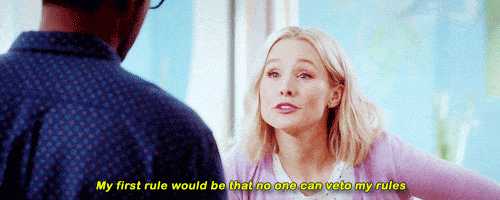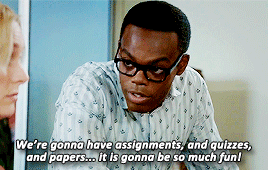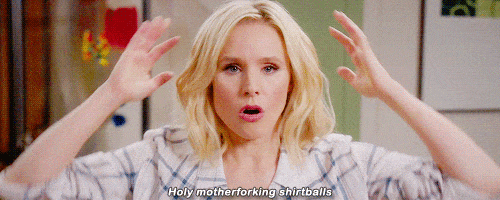Warning: SPOILERS through the most recent episode of The Good Place
During my marathoning of The Good Place with Kylie, I quickly saw that this show was exactly as smart and hilarious as I’d heard it was supposed to be. But, more than that, it started to dawn on me that The Good Place was more than just another too-clever-for-its-own-good NBC Comedy that would be critically acclaimed, but do terribly in the ratings. That it’s about the complexities of life, death, relationships, and modern application of ethics. It is all of those things, and much more, but also more than just much more.
That’s because, and wait for this, The Good Place is about itself. Specifically, it’s a show about a far-too-clever NBC comedy stuck in a cycle of development wherein the network and showrunners try to figure out what would get them the highest ratings by refilming, rebooting, and retooling everything under the sun. I’m completely serious. It all just sort of clicked for me at around episode eight of the first season, for whatever reason. Oh, and full spoilers ahead! So go watch the show and come back if you want to avoid those! Also I’m not gonna go into detail about the surface-level stuff too much so if you read this anyway it’s gonna get weird real fast! Probably.
Anyway, the more I watched, the more the picture became clear. It was too perfect to be accidental. The Good Place is a show about NBC comedies, but not in the same way that 30 Rock was. The meta-narrative in 30 Rock was part of the explicit premise, especially with Tina Fey reluctantly casting herself as the head writer of TGS as well as being that for the show itself. The Good Place, however, doesn’t present itself as a meta-narrative until you actually see it. On the surface it’s just another niche comedy made by an amazing team, but once it clicks, the whole thing just goes in loops and the show rises to absurd heights.
Let’s start with something simple. There’s no swearing in The Good Place because, initially, why would anyone need to “curse” in heaven? Replacements are made that act like active censorship for the characters —fork and shirt— thus getting around FCC regulations and avoiding the sometimes comedic but still jarring bleeps. At first, I thought this was just another clever writing mechanic, similar to Battlestar Galactica’s use of “frak” instead of “fuck”. But, later on, it’s revealed that the proverbial Good Place is in actuality an experimental Bad Place where four specific individuals are set up to torture each other for eternity. The rest of the neighborhood is populated entirely by demons acting like humans to sell the farce and torture them more explicitly.
The forcible censorship on Michael’s part to better sell his plan to his bosses (because pissing Eleanor off in such a subtle way was perfect) is clearly meant to be a stand-in for a writer’s room trying to work with FCC and network regulations for what language can and cannot be used in the show they’re developing. But, that one is an easy connection, right? Let’s see what happens if we go a bit deeper.
Michael is probably our greatest point of entry here. He’s a demon who has existed since the dawn of time itself and inhabits the body of a human to better understand how to torture them. He’s been an apprentice Bad Place Designer for all of time and his revolutionary Fake Good Place idea is his big chance to impress his superiors. In other words, he’s a writer that got a shot at developing his own show, and it’s actually his passion project. His dream show. He’s been in the industry for a long time, but he’s never been given an opportunity to really strut his stuff. And here’s where it starts to get amazing.
See, Michael’s project is brilliant, but he’s having trouble getting it off the ground. He manages to make a connection with the real Good Place by stealing a Good Janet to better sell the ruse, but she proves to be an invaluable part of the plan and foundation of the proverbial Good Place itself. If Michael is the showrunner, then Janet is the co-creator/producer of the show.
Her job is to make sure everything runs smoothly for the audience, the cast, and the crew, and also act as a check on Michael’s more wild ideas to make sure things don’t get too crazy. Thing is, like many great producers who work on cult classic tv shows, she gets so invested in the project that her job becomes less about balancing things out but rather ensuring the survival of not only herself but the dream as a whole.
She also acts as the script supervisor, ensuring that the world remains consistent cohesive. Keeping an eye on continuity, that sort of thing. This role of hers is made the most clear when she stops being able to perform it and their entire fabricated reality starts to eat itself due to far too strong of an emotional attachment to her original relationship with Jason — or rather a previous iteration of the show.

The premise of Michael’s torture plan is far too smart and complex for it to be successful (ratings-wise), basically exactly what modern NBC comedies are known for. Parks and Recreation (which The Good Place creator Michael Shur also created), Community, 30 Rock, Scrubs, and Seinfeld (which was initially a ratings disaster) are all clear examples of this phenomenon. Yet we remember and even adore those shows, even now. Seinfeld especially is more or less considered immortalized in the cultural zeitgeist, as we still call that the biggest show on TV despite Friends having surpassed it by every metric in existence aside from cultural impact, but we’ll circle back to that concept.
The entire first season of The Good Place, and thus the first iteration of Michael’s neighborhood, is basically the “unaired pilot” that most television shows film before being picked up for a series. But, at the end of the season, Eleanor figures out they’re actually in the Bad Place, thus uprooting the entire project and derailing everything.
Michael gets angry because his plans aren’t working, so he needs to go back to the drawing board and readjust. So he goes for a clean slate, wiping the memories of the four humans and starting over from the foundations. He then quickly gets caught in a loop for over eight hundred reboots. Or rather, rewrites. Why? Because the Fake Good Place isn’t just hell. It’s Development Hell. Yeah, let that one sink in. The first scene of every reboot only reinforces this. “You’ve made it to the good place.” may as well be identical to “you’ve been picked up for series!”. Except they never were. Over the course of over eight hundred iterations, Michael tries everything he possibly can to make this project work. But nothing ever does because the narrative falls apart the moment someone, almost always Eleanor, figures out it’s the Bad Place.

There’s an entire episode dedicated to the absurdity of forced TV relationships and love confessions where everyone says they love everyone else but then realizes they were freaking out and didn’t mean it by the end of the episode. This is also exactly why one reboot had Chidi and Eleanor say they love each other despite that conflicting with everything we know about them and their relationship. It didn’t make sense because it wasn’t supposed to; Michael just threw things at the wall to see if it would stick, and somehow a lizard constantly pooping on Eleanor led to that.
And no matter how many times Michael recasts roles (Eleanor’s constantly changing soulmate is a great example of this, not to mention Vicky’s frustration with the production as a whole) or reworks aspects of the plot (Tahani being drunk at the party instead of Eleanor, the endless chain of different themed restaurants) he can never get it right. Every reboot is a refilmed pilot that just doesn’t work. All the while, he’s been reporting that everything is going according to plan to Shawn, his boss, who is basically the equivalent of Russell Dowripple from Seinfeld. The President of NBC. The guy that is demonized as the one responsible for “retiring” shows before their time (hence the torture of the same name). Basically, he’s hiding the fact that he is hilariously over budget and failing to meet deadlines.
What a way to demonize network executives, am I right? Eh?
It gets to the point where his entire crew starts rebelling against him, since he’s taken things so far off the rails that they can’t cover for him anymore. It’s at this point that Michael decides to join forces with the four humans he’s been torturing for God knows how long for survival. In other words, Michael realizes that the problem wasn’t the story; it was that he wasn’t willing to stray from his original vision and refused to let it play out on its own terms. He couldn’t accept where the story would organically go, even if it happened over eight hundred times.
Once he does join Team Cockroach, the story gets flipped on its head. It becomes about escaping the Bad Place and getting into the real Good Place. A story about an NBC comedy too smart for its own good managing to make it to broadcast so that it can become essentially immortal, as all modern media technically is. The four characters who get to ride that proverbial, and sometimes literal, train to immortality are also much deeper than they appear to be. And they’re already pretty damn deep. They serve as stand-ins for four very specific viewer demographics.

Eleanor represents the more…rabid forms of fandom. Hyper-Genre Savvy. Those who think they can outthink the showrunners and theorize on reddit, or claim that something is out of character in a rant. They’re toxic and rarely listen to other’s opinions…but they’re the kind of person who just absolutely inhales this kind of tv show. They love feeling smart and being rewarded for paying attention, even if surprising them leads to them raging at creators. She would also be what is considered a “gatekeeper fan,” who thinks this piece of media should only be consumed by specific kinds of people.
Tahani, on the other hand, represents viewership that is “above” the pedestrian shows of network television. The elitist types who don’t watch television as a confusing status symbol, or refuse to watch anything without some sort of “paywall,” which is often associated with quality or pedigree. This goes hand in hand with her personality throughout the show, as she keeps name dropping celebrities, ridiculous words, and her accomplishments — she has cable and she could be watching far more prestigious television, like HBO, Starz, Showtime, or the BBC.

Chidi is a little harder to nail down, but he’s one of my favorites in this meta-textual context. Basically, he’s the fan who never stops talking or debating about shows like this. He’s in the same circles as Eleanor, but he’s trying to bring people into the fold of enjoying the show (hence why his goal of teaching moral philosophy in hell is so opaque and unappealing) in the most annoying way possible. It comes from a place of love, but he can’t seem to communicate that.
He’s the one who quotes these shows non-stop, and sees their themes, motifs and messages as revelatory or groundbreaking…while also deconstructing them and pointing out problematic aspects or other mistakes. Not out of malice, but out of instinctual curiosity. And that could be true, but he’s also part of the reason that enables people like Eleanor to gatekeep in the first place: he makes it seem like only the smartest of the smart can enjoy it, when he’s really trying to include everyone.

So he’s basically the Fandomentals, except less eloquent.
And then there’s Jason. Oh, Jason. It’s too perfect. Jason represents the “lowest common denominator,” that is the people this show would not be marketed to which is why he never understands anything that’s going on. But it’s the kind of person a network would want this show to try and include in viewership, because money. So he’s stuck there.

Circling back to the meta-narrative overall, this show is also self-aware enough of its network, premise, and sheer existence that it also serves as a sort of call-out for the dreck that network TV keeps pumping out. The constant police procedurals and dramas with white dudes who are great doctors but also assholes for some reason. It’s all “safe” and formulaic. At best, they can be mediocre since even the worst shows have moments of clarity. Mostly. And this is where we come to Mindy St. Claire.
Mindy St. Claire is the perfect representation of “middle-of-the-road” shows—programs that were on the air way too long because of syndication and familiarity. These were most common in the 70s and 80s, but a few dragged on into the 90s. And yes, a few, like the hellscape that is The Big Bang Theory still exist today. The era of her death is not incidental just so they could make cocaine jokes; it’s also because television executives snorted a ton of coke during the 80s. That was like, a huge thing.
Anyway, the height of this trend was back when there were no other real options for home entertainment. Mindy’s coke addiction is a good metaphor for the formulaic nature of those shows. Nothing ever changed and it was always “there’s nothing else on,” and you always needed more. Shows like Friends, Married with Children, The Nanny, Cheers (which Ted Danson starred in, ironically enough), Frasier, The Cosby Show, Different Strokes, The Jeffersons, Happy Days, The Facts of Life, and Night Court are great examples of this, but the list is very long.

And then, in the most recent episode, we got another bombshell in this meta-narrative. Our heroes make it to the Judge, named Jen (short for Hydrogen), and beg her to take their case in order to get into the Good Place. She agrees, because she’s bored as hell and hasn’t had anything to really do for a while. Not only is the entire sequence of their tests hilarious, and heartfelt at times, but it’s representative of what Jen is supposed to be.
She’s the physical manifestation of an outdated and arbitrary grading system used to evaluate who gets to stay and who gets thrown out into the abyss. She’s the Nielsen Ratings. These days, television shows don’t really pay much attention to actual ratings, even if they’re on networks. But back before streaming became as big as it is, those dumb little set-top boxes in a few thousand homes across the United States were basically how television shows lived and died. It calculated how much ad revenue was gained per episode, and a bunch of other factors, but ultimately, it was a system that only made sense when there were only three or four channels. Not when there are thousands.
So, yeah, to get to the Good Place, to become immortal, our heroes have to get past the biggest wall in television. The one thing that they were never meant to achieve, due to how their circumstances were created in the first place. High ratings. Which is, of course, impossible, and the meta-textual stakes aren’t quite as high as they could be since The Good Place has already been renewed for a third season.
Seriously, go watch it. It’s amazing. Season 1 is streaming on Netflix!


